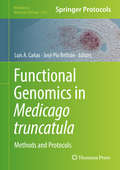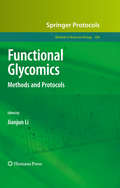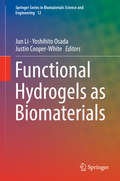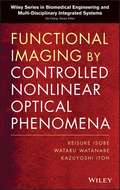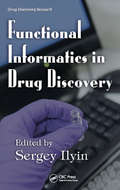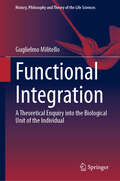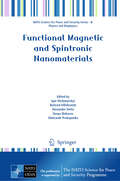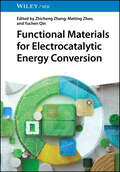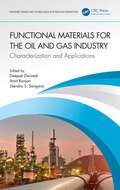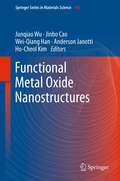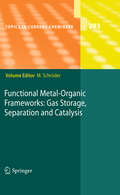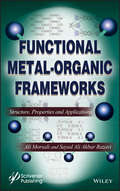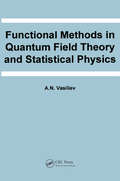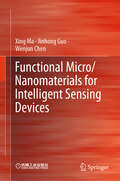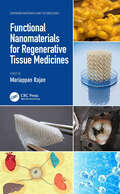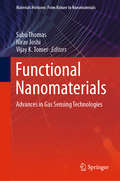- Table View
- List View
Functional Genomics in Medicago truncatula: Methods and Protocols (Methods in Molecular Biology #1822)
by Luis A. Cañas José Pío BeltránThis volume discusses popular methods to achieve different types of mutagenesis and forward/reverse genetics in Medicago truncatula. Several studies on genetic control of developmental and metabolic processes in this model legume are also described. The chapters in this book cover topics such as Targeting Induced Local Lesions IN Genomes (TILLING), Fast Neutron Bombardment (FNB), Tnt1 insertional mutagenesis, Virus-Induced Gene Silencing (VIGS), stable inactivation of microRNAs in roots, gene editing by CRISPR-Cas9, etc. This book also contains reviews on the specific use of these techniques in functional studies on the genetic control of seed, leaf, root, nodule, floral and fruit development in M. truncatula. Written for the highly successful Methods in Molecular Biology series format, chapters contain the kind of detailed description and implementation advice needed to promote success in the lab.Cutting-edge and thorough, Functional Genomics in Medicago truncatula: Methods and Protocols is a valuable resource for anyone interested in learning more about this developing field.
Functional Glycomics
by Jianjun LiThe study of functional glycomics requires the continuous development of rapid and sensitive methods for the identification of glycan structures and integration to structure-function relationships. In Functional Glycomics: Methods and Protocols, a panel of world-renowned experts provide new developments and emerging glycomics techniques in the form of detailed protocols exploring the fundamental challenges and most cutting-edge novel applications. Written in the highly successful Methods in Molecular BiologyTM series format, chapters in this volume present brief introductions to their respective topics, lists of the necessary materials and reagents, step-by-step, readily reproducible laboratory protocols, and notes sections, highlighting key tips on troubleshooting and avoiding known pitfalls. Authoritative and easy to use, Functional Glycomics: Methods and Protocols serves as an ideal reference for scientists working in biochemistry, molecular biology, cell biology, immunology, microbiology, and virology and a guide to appropriate techniques and the design of achievable research plans in this vital field.
Functional High Entropy Alloys and Compounds
by Yong Zhang Yonggang Yao Haojie LiuAn up-to-date guide to understanding, designing, and using high entropy materials In Functional High Entropy Alloys and Compounds, a team of distinguished researchers delivers a comprehensive exploration of high entropy materials for functional applications. It’s an interdisciplinary discussion highlighting the role of high entropy materials in various industries and examines the real-world applications of high entropy alloys and compounds. The authors illustrate the potential of these materials to transform different industries and cover both bulk HEA materials and HEA nanoparticles. Functional High Entropy Alloys and Compounds offers a structured and in-depth exploration of high entropy materials. It examines critical fundamentals, including their characteristics, structures, phase transformations, and microstructures, as well as corrosion, anti-oxidation, and additive manufacturing and phase control. Readers will also find: A thorough introduction to the functional properties of high entropy materials Comprehensive explorations of the real-world applications of high entropy materials, including 3D printing, thermoelectrics, optoelectronics, thermal catalysts, electro-catalysts, and energy storage Practical discussions of nanoscale high entropy materials and high entropy materials for thermal-catalytic applications Complete treatments of clean energy and electrocatalysis and high entropy materials for energy storage Perfect for materials scientists, metallurgists, electrochemists, and catalytic chemists, Functional High Entropy Alloys and Compounds will also benefit aerospace engineers and physicians and thermodynamics physicists.
Functional Hydrogels as Biomaterials (Springer Series in Biomaterials Science and Engineering #12)
by Jun Li Yoshihito Osada Justin Cooper-WhiteThis book introduces readers to the latest advances in hydrogel biomaterials, mainly focusing on the emerging areas of synthetic and biopolymer hydrogels formed through specially designed chemical or physical crosslinking, and the cyclodextrin-based host-guest supramolecular self-assembly, for cell encapsulation, cell expansion, cell differentiation and tissue repair, stem cell culture, and cellular therapy and drug delivery applications. The book was written by experts at the forefront of these interdisciplinary areas and is intended for all researchers working in the fields of biomaterials and biomedical engineering, as well as medical professions. Jun Li is a Professor at the Department of Biomedical Engineering, National University of Singapore, Singapore. Yoshihito Osada is a Professor at RIKEN Advanced Science Institute, Japan. Justin Cooper-White is a Professor at the Australian Institute for Bioengineering and Nanotechnology, University of Queensland, Australia.
Functional Imaging by Controlled Nonlinear Optical Phenomena
by Kazuyoshi Itoh Wataru Watanabe Keisuke IsobeUltrafast lasers allow high-precision imaging and manipulation for biological and medical applications. Nonlinear optical microscopy has provided researchers with unique possibilities of three-dimensional imaging of biological cells and tissues. Nonlinear optical imaging technique is a rapidly emerging research area with widespread fundamental research and clinical applications. Nonlinear optical imaging allows both structural and functional imaging with cellular level resolution imaging in biological systems. The introduction of endogenous or exogenous probes can selectively enhance contrast for molecular targets in a living cell as well as supply functional information on processes. With the aim to control nonlinear optical processes and to obtain functional images, nonlinear optical processes can be controlled by photo-controlled probes and/or parameters of ultrafast laser pulses, such as time, space, polarization, and phase.This book gives an overview of the nonlinear optical process by ultrafast laser pulses and explains how the basics of nonlinear optical microscopy led to the most advanced techniques of photo-controlled nonlinear optical microscopy.
Functional Inference in Paleoanthropology: Theory and Practice
by David J. DaeglingIn this deep examination of functional morphology, a renowned paleoanthropologist offers a new way to investigate human evolution through the fossil record.It is common for two functional anatomists to examine the exact same fossil material, yet argue over its evolutionary significance. How can this be? Traditionally, paleoanthropology has interpreted hominin fossil morphology by first considering the ecological challenges hominins faced, then drawing adaptive inferences based on the idea that skeletal morphology is largely a reflection of paleoecology. In Functional Inference in Paleoanthropology, innovative paleoanthropologist David J. Daegling suggests that researchers can resolve dichotomous interpretations of the fossil record by instead focusing on the biology and development of the bones themselves—such as measurable responses to deformations, stresses, and damage. Critically exploring how scientists probe and interpret fossil morphology for behavioral and adaptive inferences, Daegling makes the case that an intelligible science of functional morphology in the fossil record is impossible without the inclusion of this mechanobiological perspective. Drawing on historical examples from long-standing debates on the emergence of bipedality and the dietary shifts that facilitated the emergence of the hominin clade, Daegling traces the disjunctions between theoretical principles of comparative morphology and methodological practice in the paleontological context of human evolution. Sharing rich findings from recent decades of research in skeletal biomechanics, Functional Inference in Paleoanthropology examines how bone adapts over the lifespan, what environmental factors influence its quality, and how developmental constraints limit the skeleton's adaptive potential over evolutionary time.
Functional Informatics in Drug Discovery (Drug Discovery Ser. #Vol. 9)
by Sergey IlyinIntegrating various technologies with informational systems provides vast improvements to the overall research and development that occur in the biopharmaceutical industry. One of the first books to explore this area, Functional Informatics in Drug Discovery examines all aspects of technology integration and information flow in a biopharmaceutical
Functional Integration: A Theoretical Enquiry into the Biological Unit of the Individual (History, Philosophy and Theory of the Life Sciences #38)
by Guglielmo MilitelloThis book explores the main biological dimensions underlying functional integration and examines how they contribute to defining a biological individual as both a physiological and evolutionary unit. Functional integration lies at the heart of most definitions of both organisms and biological individuals, making it explanatorily relevant to biology as well as to the philosophy of biology. However, the notion—typically referring to any causal interdependence among biological functions—remains broad and lacks a coherent theoretical framework. This work addresses that gap by focusing on functional integration at the cellular level, which presents both a minimal degree of complexity (relative to multicellular organisms) and maximal conceptual significance for this inquiry. By analysing the transition from prokaryotes to eukaryotes, the book sheds light on how spatial constraints, system-level regulatory mechanisms, spatio-temporal coordination, and system-level reproduction contribute to characterizing biological organization as a functionally integrated physiological unit. This study opens the way for a fresh reflection on the foundations of biological individuality, offering insights not only for researchers, but also for students and non-specialist readers.
Functional Lipidomics
by Li Feng Glenn D. PrestwichLipids play an essential role in cell signaling and subcellular structure. Systematic analysis of the total lipid structure of a cell or organism, the lipodome, can reveal novel avenues of therapeutic intervention and diagnosis. This analysis is best modeled after the lessons learned from proteomics. With contributions from pioneering researchers f
Functional Magnetic and Spintronic Nanomaterials (NATO Science for Peace and Security Series B: Physics and Biophysics)
by Igor Vladymyrskyi Burkard Hillebrands Denys Makarov Alexander Serga Oleksandr ProkopenkoMacroscopic objects made of magnetic materials have been known to mankind for several thousand years and are widely used in various fields of human activity. With the development and practical implementation of microelectronics, and more recently nanoelectronics, it has become possible to develop and manufacture magnetic nanomaterials, dramatically expanding the scope of magnetics in modern technologies. Today, magnetic nanomaterials and nanostructures are key components of advanced information technologies. They are widely used in eMobility, medicine, sensors, robotics, etc., and have significant potential for application in prospective smart wearables and human-machine interfaces. This volume outlines recent research in the field of functional magnetic and spintronic materials. Each of the 10 chapters in the volume is self-contained, allowing the topics to be explored independently of the material in other chapters. The book covers the entire “life cycle” of magnetic/spintronic nanomaterials: from theoretical and numerical studies of their properties (Ch. 1), fabrication and experimental study of film systems (Ch. 2), fabrication of nanostructures (Ch. 3), study of electromagnetic phenomena occurring in such nanostructures (Chs. 4-10), to the use of these nanostructures in new technologies, particularly in spintronic energy harvesting (Ch. 9) and quantum sensing (Ch. 10). Some of the contributions to this volume were presented as lectures and reports at the Advanced Research Workshop “Functional Spintronic Nanomaterials for Radiation Detection and Energy Harvesting” (25–27 September 2023, Kyiv, Ukraine), which was supported by the NATO Science for Peace and Security Programme.
Functional Materials for Electrocatalytic Energy Conversion
by Zhicheng Zhang Meiting Zhao Yuchen QinBuild the energy sources of the future with these advanced materials The search for clean and sustainable energy sources capable of meeting global needs is the defining challenge of the current era. Renewable sources point the way forward, but their intrinsic instability creates an increased urgency for the development of large-scale energy storage systems comprised of stable, durable materials. An understanding of functional materials of this kind and the catalytic processes in which they’ll necessarily be incorporated has never been more essential. Functional Materials for Electrocatalytic Energy Conversion provides a systematic overview of these materials and their role in electrocatalytic conversion processes. Covering all major energy-producing reactions, as well as preparation methods and physiochemical properties of specific materials, it constitutes a major contribution to the global renewable-energy project. Functional Materials for Electrocatalytic Energy Conversion readers will also find: Guidance for the design and construction of functional materials Detailed treatment of reaction processes including hydrogen evolution, oxygen reduction, oxygen evolution, and many more Critical discussion of cutting-edge processes still under development, such as liquid fuel oxidation and oxygen reduction Functional Materials for Electrocatalytic Energy Conversion is ideal for materials scientists, electrochemists, catalytic chemists, and any other researchers working with energy conversion and storage.
Functional Materials for the Oil and Gas Industry: Characterization and Applications (Emerging Trends and Technologies in Petroleum Engineering)
by Amit Ranjan Jitendra S. Sangwai Deepak DwivediFunctional Materials for the Oil and Gas Industry: Characterization and Applications discusses the latest techniques in characterization and applications of functional materials in the oil and gas industry. It provides an expert review of recent developments in a variety of materials, such as ceramics, composites, and alloys, and covers all major aspects relevant to the industry, including asset management (corrosion), operation (pipeline engineering), energy management, and applications in extreme environments. This book: • Discusses modern characterization techniques, such as in situ TEM, SAXS, SANS, X-ray, and neutron tomography. • Covers conventional and advanced nondestructive techniques (NDTs), such as ultrasonic testing and radiography for asset integrity checking in oil and gas sectors. • Describes advanced properties of a variety of functional materials and their applications to the oil and gas field. • Explains self-cleaning coating technologies and their applications and materials for renewable energy sources. • Details advances in synthesis methods for functional materials. • Features industrial aspects of afunctional materials application in each chapter. Written for an interdisciplinary audience of industrial practitioners, academics, and researchers in petroleum, materials, chemical, and related disciplines of engineering, this work offers significant insight into the state-of-the-art in the development and characterization of advanced functional materials.
Functional Mesoporous Carbon-Based Film Devices for Energy Systems
by Lei Xie Biao Kong Hongbin Xu Shan ZhouThis book introduces the synthesis of functional mesoporous carbon-based films and their applications in energy systems. In the last decades, the consumption of fossil fuels has led to many problems such as the energy crisis and climate change. The rapidly increasing energy demands and environmental issues have attracted lots of attention to develop new functional materials for sustainable energy technology. Mesoporous carbon-based films show unique properties and have been regarded as a promising material applied in highly efficient energy storage and conversion systems. Interfacial assembly strategies are usually employed to construct such film devices. In this book, recent developments in synthesis of mesoporous carbon-based film devices through interfacial assembly strategies are illustrated. Additionally, the applications of mesoporous carbon-based film devices for electrochemical energy systems including batteries and electrocatalysis are introduced to demonstrate their potential, as well as describing the mechanisms to enhance the performance of these systems. Finally, some challenges and future outlooks are presented to inspire better development and contributions to this field in coming years. Given its scope, this book appeals to undergraduate students, graduate students, engineers, and researchers involved in related fields.
Functional Metal Oxide Nanostructures
by Junqiao Wu Jinbo Cao Wei-Qiang Han Ho-Cheol Kim Anderson JanottiMetal oxides and particularly their nanostructures have emerged as animportant class of materials with a rich spectrum of properties and greatpotential for device applications. In this book, contributions from leadingexperts emphasize basic physical properties, synthesis and processing, and thelatest applications in such areas as energy, catalysis and data storage. Functional Metal Oxide Nanostructuresis an essential reference for any materials scientist or engineer with aninterest in metal oxides, and particularly in recent progress in defectphysics, strain effects, solution-based synthesis, ionic conduction, and theirapplications.
Functional Metal-Organic Frameworks: Gas Storage, Separation and Catalysis
by Martin Schröder- Microporous Organic Polymers: Design, Synthesis, and Function By J.-X. Jiang and A. I. Cooper - Hydrogen, Methane and Carbon Dioxide Adsorption in Metal-Organic Framework Materials By X. Lin, N. R. Champness, and M. Schröder -Doping of Metal-Organic Frameworks with Functional Guest Molecules and Nanoparticles By F. Schröder and R. A. Fischer -Chiral Metal-Organic Porous Materials: Synthetic Strategies and Applications in Chiral Separation and Catalysis By K. Kim, M. Banerjee, M. Yoon, and S. Das -Controlled Polymerization by Incarceration of Monomers in Nanochannels By T. Uemura and S. Kitagawa -Designing Metal-Organic Frameworks for Catalytic Applications L. Ma and W. Lin -Magnetic and Porous Molecule-Based Materials By N. Roques, V. Mugnaini, and J. Veciana
Functional Metal-Organic Frameworks: Structure, Properties and Applications
by Ali Morsali Sayed Ali Akbar RazaviOwing to the extensive interest in construction of functional metal organic frameworks (FMOFs), this book discusses the roles of functional groups on the structure and application of metal organic frameworks (MOFs). The contents of the book are classified based on the structural and chemical properties of organic functions, in order to make readers able to compare the different effects of each function on the structure and application of the MOFs. In each chapter, the chemical properties of applied functional groups are gathered to give deeper insight into the roles of organic functions in the structure and application of MOFs. In the function-application properties, the authors discuss how a functional group can dominate the host-guest chemistry of the MOFs and how this host-guest chemistry can expand the effectiveness and efficiency of the material in different fields of applications. Finally, function-structure properties are discussed. In function-application properties, it is discussed how a functional group can affect the topology, porosity, flexibility and stability of the framework. The features of this subject are novel and are presented for the first time.
Functional Methods in Quantum Field Theory and Statistical Physics (Frontiers In Physics Ser.)
by A.N. VasilievProviding a systematic introduction to the techniques which are fundamental to quantum field theory, this book pays special attention to the use of these techniques in a wide variety of areas, including ordinary quantum mechanics, quantum mechanics in the second-quantized formulation, relativistic quantum field theory, Euclidean field theory, quant
Functional Micro/Nanomaterials for Intelligent Sensing Devices
by Xing Ma Jinhong Guo Wenjun ChenThis book offers a comprehensive exploration of functional micro/nanomaterials and their integration into intelligent sensor devices. It primarily delves into surface-enhanced Raman substrate probes, Surface-enhanced Raman spectroscopy (SERS) sensing detection mechanisms, lateral flow immunoassay probes, and optical nanoprobe technologies, underscoring their significance in biomedical detection. Moreover, it provides an in-depth analysis of the intelligent sensing capabilities of magnetic nanoparticles, one-dimensional nanomaterials, two-dimensional nanomaterials, liquid metal micro/nanostructures, and micro/nanomotors. This book is particularly beneficial for those with a foundational understanding of nanomaterials and a keen interest in functional micro/nanomaterials and intelligent sensing technologies. It enables readers to gain a thorough understanding of the properties and characteristics of functional micro/nanomaterials, the underlying principles of signal generation in sensing detection, and offers insights into the latest research developments and existing challenges within the field of intelligent sensing applications. The basis of English translation of this book, originally in Chinese, was facilitated by artificial intelligence. The content was later revised by the authors for accuracy.
Functional Molecular Materials: An Introductory Textbook
by Matteo Atzori Flavia Artizzu<p>The field of molecular materials represents an exciting playground for the design, tailoring, and combination of chemical building blocks as carriers of physical properties and aims at the understanding and development of novel functional molecular devices. Within this extraordinarily widespread framework, the realization of materials with the desired functionalities can only be achieved through a rational design strategy based on a solid understanding of the chemical and physical features of each constituting building block. <p>This book provides a general overview of molecular materials, discussing their key features in a simple and organic way by focusing more on basic concepts rather than on specialized descriptions, in order to supply the non-expert reader with the immediate fundamental tools and hints to understand and develop research in this field. With this view, it is a step-by-step guide toward the preparation of functional molecular materials, where the knowledge and understanding so far attained by the scientific community through the investigation of significant archetypical examples is deconstructed down to the fundamental basis and then presented in reverse, from the base to the top.</p>
Functional Molecular Silicon Compounds I
by David ScheschkewitzThe series Structure and Bonding publishes critical reviews on topics of research concerned with chemical structure and bonding. The scope of the series spans the entire Periodic Table and addresses structure and bonding issues associated with all of the elements. It also focuses attention on new and developing areas of modern structural and theoretical chemistry such as nanostructures, molecular electronics, designed molecular solids, surfaces, metal clusters and supramolecular structures. Physical and spectroscopic techniques used to determine, examine and model structures fall within the purview of Structure and Bonding to the extent that the focus is on the scientific results obtained and not on specialist information concerning the techniques themselves. Issues associated with the development of bonding models and generalizations that illuminate the reactivity pathways and rates of chemical processes are also relevant. The individual volumes in the series are thematic. The goal of each volume is to give the reader, whether at a university or in industry, a comprehensive overview of an area where new insights are emerging that are of interest to a larger scientific audience. Thus each review within the volume critically surveys one aspect of that topic and places it within the context of the volume as a whole. The most significant developments of the last 5 to 10 years should be presented using selected examples to illustrate the principles discussed. A description of the physical basis of the experimental techniques that have been used to provide the primary data may also be appropriate, if it has not been covered in detail elsewhere. The coverage need not be exhaustive in data, but should rather be conceptual, concentrating on the new principles being developed that will allow the reader, who is not a specialist in the area covered, to understand the data presented. Discussion of possible future research directions in the area is welcomed. Review articles for the individual volumes are invited by the volume editors. Readership: research scientists at universities or in industry, graduate students Special offer For all customers who have a standing order to the print version of Structure and Bonding, we offer free access to the electronic volumes of the Series published in the current year via SpringerLink.
Functional Morphology of Feeding and Grooming in Crustacea
by Bruce E. Felgenhauer Anne. B Thistle L. WatlingAbetted by recent technological advances in scanning and transmission electron microscopy, as well as new preparative methods, these contributions examine crustacean anatomy, demonstrating (or at least inferring) the functions of morphological features. In addition to feeding and grooming, they also
Functional Nanomaterials and Nanocomposites for Biodegradable Food Packaging (Smart Nanomaterials Technology)
by Madhusudhan Alle Shiv Dutt Purohit Ruchir PriyadarshiThis book covers the recent developments in biopolymer nanocomposite materials and their possible impact on the food packaging industry. The food industry has been one of the highest consumers of plastics for the past two decades, where plastics have been used in huge amounts as food packaging materials. The generation of non-biodegradable plastic-based municipal solid waste, especially due to food packaging industry, has now become one of the two paramount problems faced by the world today. The other problem is being the wastage of food in humongous quantities annually. With the onset of globalization, food produced in one part of the world became available to people living in another part. However, during transportation and storage, a plethora of food gets wasted due to microbial contamination of chemical oxidation. This book looks into biopolymer nanocomposites, and it’s the ability to address both these issues. It presents the very essence of biopolymer nanocomposite technology with the combination of various nanomaterials and biopolymer to yield a functional product for food packaging, which is demonstrated in the various chapters. In general, this book caters to the needs of students involved in nanotechnology, biotechnology, food technology, industrial chemistry, and many others other interdisciplinary subjects.
Functional Nanomaterials for Regenerative Tissue Medicines (Emerging Materials and Technologies)
by Mariappan RajanThis book covers nanomaterials in tissue engineering for regenerative therapies of heart, skin, eye, skeletal muscle, and the nervous system. The book emphasizes fundamental design concepts and emerging forms of nanomaterials in soft- and hard-tissue engineering. FEATURES Fills a gap in the literature related to the application of nanomaterials in hard- and soft-tissue regeneration, repair, and restructure Discusses a variety of applications, including cardiac, kidney, liver, bone, wound healing, artificial organs, and dental Presents advantages and limitations of various nanomaterials alongside future challenges Functional Nanomaterials for Regenerative Tissue Medicines is essential for academics and industry professionals working in tissue engineering, biomedicine, biopharmaceuticals, and nanotechnology. It is primarily intended for materials researchers (to develop the platforms related to tissue regeneration) as well as clinicians (to learn and apply nanomaterials in their practice) and industrial scientists (to develop commercial blood substitute products).
Functional Nanomaterials: Advances in Gas Sensing Technologies (Materials Horizons: From Nature to Nanomaterials)
by Sabu Thomas Nirav Joshi Vijay K. TomerThis book provides a comprehensive overview of the current state-of-art in oxide nanostructures, carbon nanostructures and 2D materials fabrication. It covers mimicking of sensing mechanisms and applications in gas sensors. It focuses on gas sensors based on functional nanostructured materials, especially related to issues of sensitivity, selectivity, and temperature dependency for sensors. It covers synthesis, properties, and current gas sensing tools and discusses the necessity for miniaturized sensors. This book will be of use to senior undergraduate and graduate students, professionals, and researchers in the field of solid-state physics, materials science, surface science and chemical engineering.
Functional Nanomaterials: Synthesis, Properties, and Applications
by Wai-Yeung Wong Qingchen DongPresents the most recent advances in the production and application of various functional nanomaterials As new synthetic methods, characterization technologies, and nanomaterials (NMs) with novel physical and chemical properties are developed, researchers and scientists across disciplines need to keep pace with advancements in the dynamic field. Functional Nanomaterials: Synthesis, Properties and Applications provides comprehensive coverage of fundamental concepts, synthetic methods, characterization technologies, device fabrication, performance evaluation, and both current and emerging applications. Contributions from leading scientists in academia and industry present research developments of novel functional nanomaterials including metal nanoparticles, two-dimensional nanomaterials, perovskite-based nanomaterials, and polymer-based nanomaterials and nanocomposites. Topics include metal-based nanomaterials for electrochemical water splitting, cerium-based nanostructure materials for electrocatalysis, applications of rare earth luminescent nanomaterials, metal complex nanosheets, and methods for synthesizing polymer nanocomposites. Provides readers with timely and accurate information on the development of functional nanomaterials in nanoscience and nanotechnology Presents a critical perspective of the design strategy, synthesis, and characterization of advanced functional nanomaterials Focuses on recent research developments in emerging areas with emphasis on fundamental concepts and applications Explores functional nanomaterials for applications in areas such as electrocatalysis, bioengineering, optoelectronics, and electrochemistry Covers a diverse range of nanomaterials, including carbonaceous nanomaterials, metal-based nanomaterials, transition metal dichalcogenides-based nanomaterials, semiconducting molecules, and magnetic nanoparticlesFunctional Nanomaterials: Synthesis, Properties and Applications is an invaluable resource for chemists, materials scientists, electronics engineers, bioengineers, and others in the scientific community working with nanomaterials in the fields of energy, electronics, and biomedicine.
